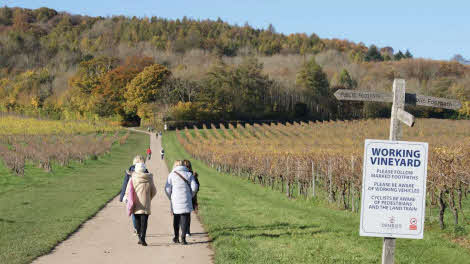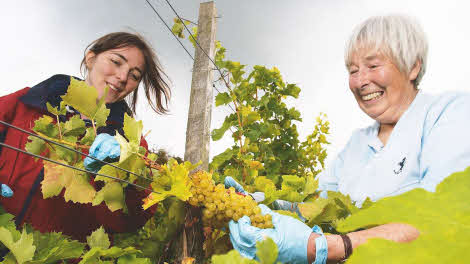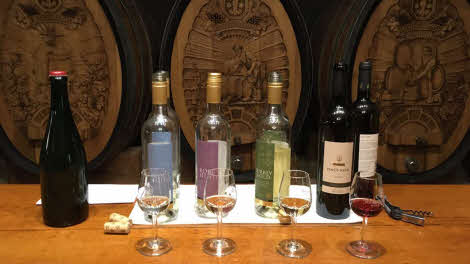Wine tours in Surrey
Jonathan Manning learns about the thriving British wine-making industry – and enjoys a glass or two for research reasons obviously! – on a vineyard tour and wine tasting experience at Denbies Estate in Surrey

There are seven miles of footpaths winding their way through the vineyards at Denbies Estates
If there’s a silver ling to the cloud of climate change, perhaps it’s the success of vineyards across the UK. Once thriving primarily on the sun-drenched hillsides of the Continent, vines are now taking advantage of Britain’s warmer summers, their resultant grape crops being turned into award-winning tipples.
One of England’s largest wine producers is Denbies Estate, tucked into the chalky hills of the North Downs, where a château-style winery and visitor centre sit at the heart of 265 acres of vines. With the sun shining onto its south-facing slopes, the estate could easily be mistaken for the Loire or Champagne regions of France, rather than a section of Surrey’s stockbroker belt, yet 35 years ago this was all just farmland.
It was also the view from the study of a local geologist, Richard Selley, an expert in the field of oil exploration. He would gaze out over the sunny, sheltered, chalky valley and think, “What a fantastic place for a vineyard.” And so, as a bit of a joke, he compiled “a little consulting report, like I might do for an oil company”. The landowner, Sir Adrian White, was looking to diversify and seized the opportunity to try growing grapes. An initial 20 acres of vines were planted in 1986 and the first wine produced seven years later; last year, Denbies won 23 international wine awards!
These days, the estate strikes a careful balance between a busy, working winery and a full-bodied visitor attraction. Seven miles of footpaths and bridleways serve as arteries through long stripes of vines and beyond into hilly woodland (there’s a land train for visitors who prefer not to walk). The trails provide the perfect window onto the vineyard as the pages of the calendar turn.

Teams of pickers harvest the grapes in late September and October Malcolm Case-Green/Alamy
During winter, each vine is pruned back to its trunk and a single branch trained along metal cables to its neighbour, like elephants linking tail and trunk during a sandstorm. With the warmth of spring, new leaves and branches race along the wires before the first bloom of flowers. Towards the end of June tiny clusters of grapes start to appear and by August the vines are heavy with fruit. Under the full heat of summer, the grapes start to turn from green to yellow or red, depending on their variety. Finally, in late September and October teams of pickers move in to harvest them: by hand for those destined to be sparkling wines; and by machine if they are to become red wine varieties. Once gathered, the alchemy begins.
With its brick and flint façade, square tower and deep sloping roof, the Denbies winery looks more Bordeaux than neighbouring Box Hill. To one side there’s the hands-on viticulture ‘factory’ for making wine, with its grape presses, fermentation tanks, barrels and bottling operation. To the other, a restaurant, café and well-stocked shop, as well as the visitor centre where I’ve signed up for a tour. A short, informative film, accompanied by a glass of Denbies fizz, runs through the history of the estate (it was once owned by Thomas Cubitt, the builder responsible for the famous façade of Buckingham Palace). Then it’s down into a vaulted cellar, lined by huge, ornate wooden barrels.
An estate map on the wall divides the vineyard into fields, each colour-coded according to the variety of grape grown within it. Eva, our brilliantly informed guide, explains that, over the years, Denbies has experimented with more than 20 types of grape, but has gradually reduced its range to 13 that thrive on the chalky soils. Some are well known, such as Chardonnay and Sauvignon Blanc, others more obscure; Ortega, Reichensteiner and Müller-Thurgau, anyone?
Eva tells us that the same grape variety can have a different flavour depending on where it’s grown on the estate, as she details the labour-intensive winemaking process, especially for sparkling wines. Many of the wines are blends of different grapes – Denbies’ popular Surrey Gold combines Müller-Thurgau, Ortega and Bacchus varieties, while its Flint Gold is made from Reichensteiner and Seyval Blanc.

A selection of the award-winning Denbies range which you can taste at the end of the tour
And then, as the first small glass is poured, I find myself faced by the age-old conundrum of behaving like teacher’s pet or class clown. “Who can taste Granny Smith apples... pears... cherries... strawberries?” asks Eva. My unsophisticated palate tastes only wine; wines I like and wines I do not. So I keep shtum, swilling the wine around the glass to release its perfume.
It is great fun tasting all the different wines and I discover that I’m partial enough to the Whitedowns sparkling wine to buy a couple of bottles on the way out. Cheers!
Three more UK vineyard destinations
Hambledon Vineyard, Hampshire : Enjoy a tour of the vineyard, learn about the winemaking process and taste a couple of sparkling wines. The Vineyard and Winery Tour costs £17.
Contact: hambledonvineyard.co.uk Stay: Rookesbury Park Club site
Rathfinny Wine Estate, East Sussex: Go for a self-guided, three-mile walking tour of the vineyard or join a tour to discover how Sussex slopes produce grapes for sparkling wines. A tour costs £20.
Contact: rathfinnyestate.com Stay: Brighton Club site
Hush Heath Estate, Kent : Take a self-guided stroll through vineyards, apple orchards and ancient oak woodlands, or join an expert-led tour and tasting experience on this estate that produces award-winning Balfour sparkling wines. The tour and tasting package costs £30.
Contact: hushheath.com Stay: Tanner Farm Touring Caravan & Camping Park AS


